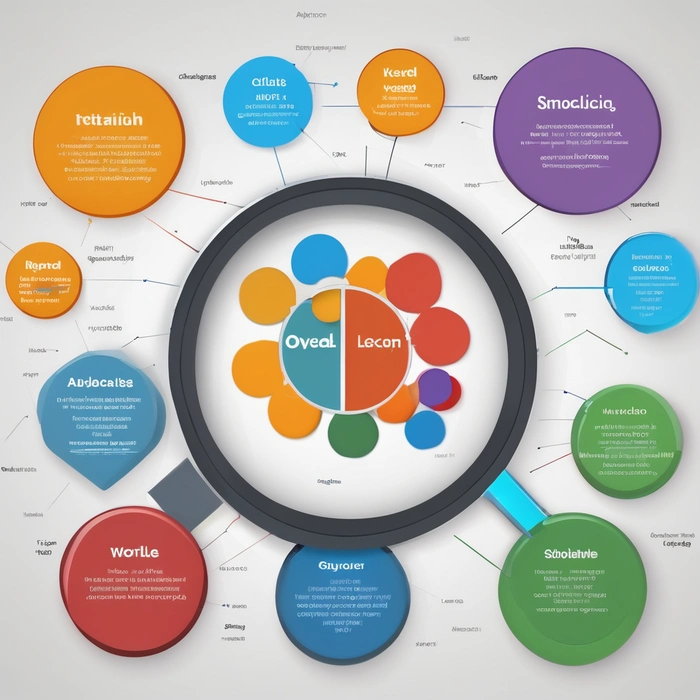what is keyword clustering?
Keyword clustering is the process of grouping keywords that are related to each other by topic or search intent. It’s a technique used in search engine optimization (SEO) to improve your website’s ranking for relevant searches.
How to Do Keyword Clustering
The process of keyword clustering typically involves the following steps:
- Do keyword research to identify a list of keywords that your target audience is searching for. You can use a variety of tools and techniques for keyword research, such as keyword research tools, competitor analysis, and Google Search Console.
- Analyze your keyword list and identify keywords that are semantically similar. Semantic similarity refers to how closely related two words or phrases are in meaning. There are a number of ways to identify semantically similar keywords, including using keyword clustering tools, manually analyzing your keyword list, and looking at the “Searches related to” section in Google search results.
- Group your keywords into clusters based on their semantic similarity and search intent. Search intent refers to the reason why someone is conducting a particular search. For example, someone searching for “king size mattress” is likely in the informational stage of the buying journey, while someone searching for “best king mattress” is likely closer to making a purchase. By grouping keywords together based on search intent, you can create content that is more targeted and relevant to your audience.
keyword clustering example
Here’s an example of how keyword clustering might work in practice. Imagine that you are a retailer that sells mattresses. You might start by doing keyword research and identifying a list of keywords that people are searching for, such as “king size mattress”, “queen size mattress”, “memory foam mattress”, and “innerspring mattress”. These keywords are all related to the topic of mattresses, but they have different search intents. By analyzing these keywords and grouping them together based on search intent, you could create the following keyword clusters:
- Informational keywords: This cluster would include keywords like “king size mattress” and “queen size mattress”. These keywords are typically used by people who are in the early stages of the buying journey and are just starting to learn about different types of mattresses.
- Transactional keywords: This cluster would include keywords like “best king size mattress” and “buy innerspring mattress”. These keywords are typically used by people who are closer to making a purchase and are looking for specific products to buy.
benefits to using keyword clustering for SEO:
- Improved website structure: Keyword clusters can help you create a more logical and organized website structure. By grouping related keywords together, you can create content that is more comprehensive and informative for users. This can lead to a better user experience, which can in turn improve your website’s SEO.
- Increased website traffic: By targeting multiple keywords with a single piece of content, you can increase your website’s traffic from organic search. This is because your content will be more likely to show up in search results for a wider variety of keywords.
- Higher search engine rankings: Google favors websites that are seen as authorities on a particular topic. By creating content that targets multiple keywords in a cluster, you can demonstrate your expertise to Google and improve your website’s chances of ranking higher in search results. This is because Google sees websites that target multiple related keywords as being more relevant to a particular topic.
- Improved content quality: Keyword clustering can also help you create higher quality content. By understanding the different search intents within a cluster, you can create content that is tailored to the needs of your audience. This can lead to more engaged users and a better overall SEO performance.
Keyword Clustering Tool
Keyword clustering tools are software programs that help you automate the process of grouping keywords into clusters. These tools can save you a lot of time and effort, especially if you are working with a large list of keywords.
There are a number of different keyword clustering tools available on the market, both free and paid. Some popular options include:
- Semrush
- KWFinder
- Serpstat
- SEOScout
- Mangools
When choosing a keyword clustering tool, it is important to consider your needs and budget. Some tools offer more features than others, such as the ability to analyze search intent and competition levels.
Best keyword clustering tool
Here are some of the factors to consider when choosing a keyword clustering tool:
- Features: What features are important to you? Some of the features that you may want to consider include the ability to upload your own keyword list, the ability to analyze search intent, the ability to see competition levels, and the ability to export your clusters in different formats.
- Price: How much are you willing to spend? There are a number of free and paid keyword clustering tools available on the market. Free tools typically offer a limited set of features, while paid tools offer more features and functionality.
- Ease of use: How easy is the tool to use? Some tools are more user-friendly than others. If you are not familiar with keyword clustering, you may want to choose a tool that is easy to learn and use.
Once you have chosen a keyword clustering tool, you can use it to group your keywords into clusters. To do this, you will typically need to upload your keyword list to the tool. The tool will then analyze your keywords and group them together based on their semantic similarity and search intent.
Here are some of the benefits of using a keyword clustering tool:
- Save time: Keyword clustering tools can save you a lot of time and effort by automating the process of grouping keywords into clusters.
- Improve accuracy: Keyword clustering tools can help you to identify clusters that you may have missed if you were clustering keywords manually.
- Get better results: By using keyword clustering tools, you can create more targeted and effective SEO campaigns.
If you are looking to improve your SEO, using a keyword clustering tool is a great way to get started.
keyword clustering aI
Keyword clustering AI refers to the use of artificial intelligence (AI) within keyword clustering tools to automate and enhance the process of grouping keywords based on semantic similarity and search intent. Here’s a breakdown of how it works:
Traditional Keyword Clustering vs. AI-powered Clustering:
- Traditional: Relies on algorithms that analyze keyword text to identify similarities. This can be effective but may miss nuances or struggle with complex topics.
- AI-powered: Incorporates AI techniques like natural language processing (NLP) to understand the deeper meaning and relationships between keywords. This leads to more accurate and insightful clustering.
Benefits of AI in Keyword Clustering:
- Improved Accuracy: AI can grasp the context and intent behind keywords, leading to more relevant clusters that better reflect user search queries.
- Identifying New Relationships: AI can uncover hidden connections between keywords you might miss manually, helping you discover new content opportunities.
- Handling Large Datasets: AI efficiently processes vast amounts of keyword data, making it ideal for extensive SEO campaigns.
- Evolving with Search Trends: AI can adapt to the ever-changing search landscape, ensuring your clusters stay relevant to current user behavior.
Examples of AI in Action:
- Identifying Entities and Topics: AI can recognize entities (like brands or products) and topics within keywords, leading to more focused clusters.
- Understanding User Intent: AI goes beyond just keywords, analyzing search queries to understand what users are truly looking for.
AI-powered keyword clustering is a powerful tool for SEOs. It streamlines the process, improves accuracy, and helps you stay ahead of the curve in the competitive world of search engine optimization.
Keyword Clustering Template
| Cluster Name | Main Topic | Keywords | Search Intent | Notes |
|---|---|---|---|---|
Here’s how to use the template:
- Fill in the “Cluster Name” column: This should be a concise phrase that captures the essence of the topic covered by the keywords in the cluster.
- Fill in the “Main Topic” column: This is a broader category that the cluster falls under. It can be helpful for organizing your clusters later.
- Fill in the “Keywords” column: List all the keywords that belong to this cluster.
- Fill in the “Search Intent” column: Indicate the intent behind the keywords in this cluster. Common search intents include informational (learning about something), transactional (buying something), commercial (researching before buying), and navigational (finding something specific).
- Fill in the “Notes” column: Use this space for any additional information about the cluster, such as content ideas, specific questions users might have within this topic, or competitor analysis for these keywords.
Tips for Using the Template:
- Start with a broad list of keywords related to your niche or target audience.
- Use keyword research tools or brainstorm terms to generate your initial list.
- Group keywords with similar search intent and meaning together.
- Aim for 5-10 keywords per cluster for better manageability.
- Use a spreadsheet program like Google Sheets or Microsoft Excel to create your template.
- This template can be easily customized to fit your specific needs. There’s no one-size-fits-all approach, so feel free to add or remove columns as needed.
By using this template, you can effectively organize your keywords into meaningful clusters that will guide your SEO content strategy. This will help you create content that targets the right audience with the right information, ultimately improving your website’s ranking and visibility in search results.

